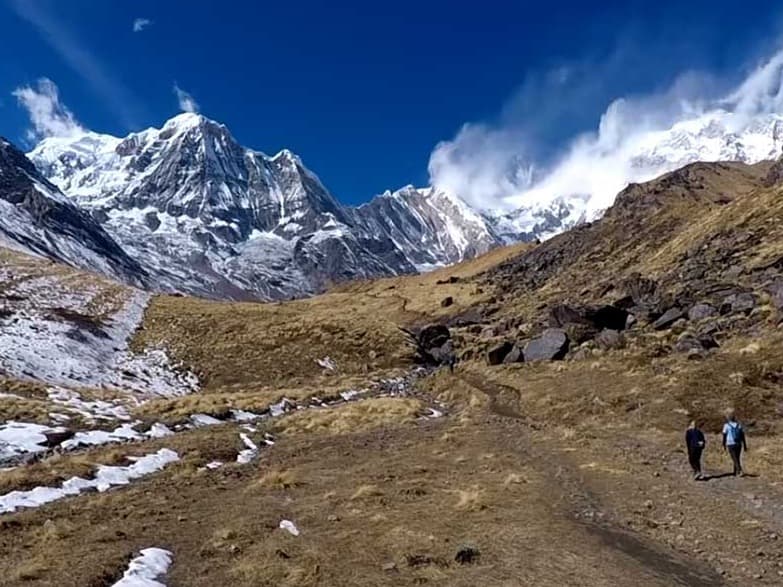Everest base camp trek is one of the most popular treks in Nepal. With more than 30,000 tourists a year, the best thing about Everest base camp trek is it provides an "adventure for a lifetime". As there is one proverb: 'life is a one time offer, use it well; Nobody should miss such a golden chance to enjoy their life in such an adventurous manner. Not only this but Everest base camp trek also provides an opportunity to become familiar with the enticing sherpa culture.
Best Season to go on EBC Trek
The perfect time to go to EBC Trek is Spring and Autumn i.e. from March to May and October to November. Winter (December to early-March) is also a good time to go EBC Trek, however, the climate gets extremely cold with heavy snowfall. Many photographers travel during this time of the year as the views are stunning and clear. Likewise, Monsoon (June-September) is not a good time to go on EBC Trek as the views become unclear with the slippery trail.
Everest Base Camp Trek difficulty
Every coin has two sides; likewise, although Everest Base Camp Trek is enjoyable, adventurous, it too has some difficulty. Some factors that create difficulty in Everest Base Camp Trek are:
- Geography of the Everest region
- Distance
- Lack of effective training time
- Guides and porters
1. Geography of the Everest region
Everest Base Camp Trek generally gets started after a small flight to Lukla, which is located at an altitude of 2,860 meters. From here, you ascend all the way up to the Everest Base Camp (5,380 m) as well as Kala Patthar (5,643 m) via Namche Bazaar, Tengboche, Dingboche, and Lobuche. At such high altitudes, there are high chances of getting altitude sickness if you do not take proper measures while gaining altitude. Along with this, high elevation can bring unpredictable weather anytime, which can also cause inconvenience during the trek.
There are different types of altitude sickness:
- Acute Mountain Sickness
- High Altitude Cerebral Edema (HACE)
- High Altitude Pulmonary Edema (HAPE)
Early symptoms of altitude sickness include headache, nausea, difficulty in breathing, etc. While chronic symptoms of altitude sickness are hallucinations, running out of breath even while walking a short distance, inability to walk in a straight line, etc.
2. Distance
The total distance, which you cover during the classic Everest Base Camp trek is approximately 130 kilometers. This means you will roughly cover 65 km ascend and 65 km descend. Walking uphills 65 km is surely strenuous than walking on flat tracks. It almost takes 12 days to complete trekking if you are trained trekker, however, it takes around 13-14 days for an untrained trekker.
3. Lack of effective training
Training helps to develop physical and mental strength needed to complete the trek. The amount of hard work you need to do to trek to Everest base camp also determines the difficulty of this trek. You need to train for at least a couple of months before embarking on the Everest base camp trek.
4.Guides and Porters
If you don't professional have a guide, you may also lose track of the trekking trails. Guides give us excellent ideas about, which part of the trek is tricky to complete, or where there is a possibility of accidental slips. Without proper guides and porters, your trek will become definitely a difficult trek.
Food and accommodation in the Everest region
Trekking is undoubtedly a very tiring activity, it is hence important that you consume enough food to keep yourself moving. For some rough area, it is important that you carry all the required resources either yourselves or on the yak. While in other areas, there are many local tea houses providing different types of beverages and satisfying food items (Indian, Tibetan, and Nepali). There is no big problem with food, drinks, and accommodations in the Everest region.
Highlights of Everest Base Camp Trek
The highlights of Everest Base Camp Trek is listed below:
- Rich Sherpa culture
- Trek through dense forests of rhododendron, pine, fir, & oak, rivers, streams, cross thrilling suspension bridges
- Visit Tengboche monastery, the biggest monastery of the Everest region
- Get to experience the daily lifestyle of locals
- Witness stunning landscape throughout the trail
- See striking glaciers and glacial lakes
- Panoramic views of Mt. Everest, Mt. Lhotse, Mt. Makalu, Mt. Nuptse, Mt. Cho Oyu, Mt. Ama Dablam






